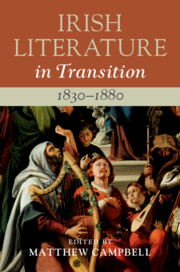Book contents
- Irish Literature in Transition, 1830–1880
- Irish Literature in Transition
- Irish Literature in Transition, 1830–1880
- Copyright page
- Contents
- Contributors
- Series Preface
- General Acknowledgements
- Acknowledgements
- Part I Contexts and Contents: Politics and Periodicals
- Part II Ireland and the Liberal Arts and Sciences
- Part III From the Four Nations to the Globalising Irish
- Part IV The Languages of Literature
- Chapter 12 Antiquarians and Authentics: Survival and Revival in Gaelic Writing
- Chapter 13 Poetry and Its Audiences: Club, Street, Ballad
- Chapter 14 Realism, Allegory, Gothic: The Irish Victorian Novel
- Chapter 15 The Rise of the Woman Writer
- Chapter 16 Dion Boucicault and the Globalised Irish Stage
- Chapter 17 Popular Prints
- Index
Chapter 14 - Realism, Allegory, Gothic: The Irish Victorian Novel
from Part IV - The Languages of Literature
Published online by Cambridge University Press: 29 February 2020
- Irish Literature in Transition, 1830–1880
- Irish Literature in Transition
- Irish Literature in Transition, 1830–1880
- Copyright page
- Contents
- Contributors
- Series Preface
- General Acknowledgements
- Acknowledgements
- Part I Contexts and Contents: Politics and Periodicals
- Part II Ireland and the Liberal Arts and Sciences
- Part III From the Four Nations to the Globalising Irish
- Part IV The Languages of Literature
- Chapter 12 Antiquarians and Authentics: Survival and Revival in Gaelic Writing
- Chapter 13 Poetry and Its Audiences: Club, Street, Ballad
- Chapter 14 Realism, Allegory, Gothic: The Irish Victorian Novel
- Chapter 15 The Rise of the Woman Writer
- Chapter 16 Dion Boucicault and the Globalised Irish Stage
- Chapter 17 Popular Prints
- Index
Summary
Bibliographical recoveries have decisively challenged older views about Victorian Ireland’s supposed failure to produce fiction, but the perception that the Irish novel was in many ways anomalous remains a hallmark of scholarship on the period, regardless of whether that anomaly is deplored or celebrated. This chapter reviews the main theories that have used sociological, cultural, ideological and economic factors to analyse the marginality and generic deviancy of Irish fiction, where realism is often overshadowed by allegorical and Gothic strains. It then suggests that the aesthetic standards that are used to assess the idiosyncrasies of Irish Victorian novels remain implicitly indebted to influential but questionable definitions of realism in Anglo-American literary criticism. While acknowledging some of Irish fiction’s differences from the realist canon, this chapter also highlights their mutual imbrication by tracing Irish influences and inspirations in the works of various English and French realists, and the latter’s roles in Irish literary history. Ireland’s paradoxical blend of peripherality and proximity to the centres of nineteenth-century European cultural production is here used to recontextualise terms like realism, allegory and Gothic, and to emphasise their porousness not just in Irish writing, but in the very canon from which Irish Victorian fiction is too often segregated.
- Type
- Chapter
- Information
- Irish Literature in Transition, 1830–1880 , pp. 238 - 256Publisher: Cambridge University PressPrint publication year: 2020
- 1
- Cited by

